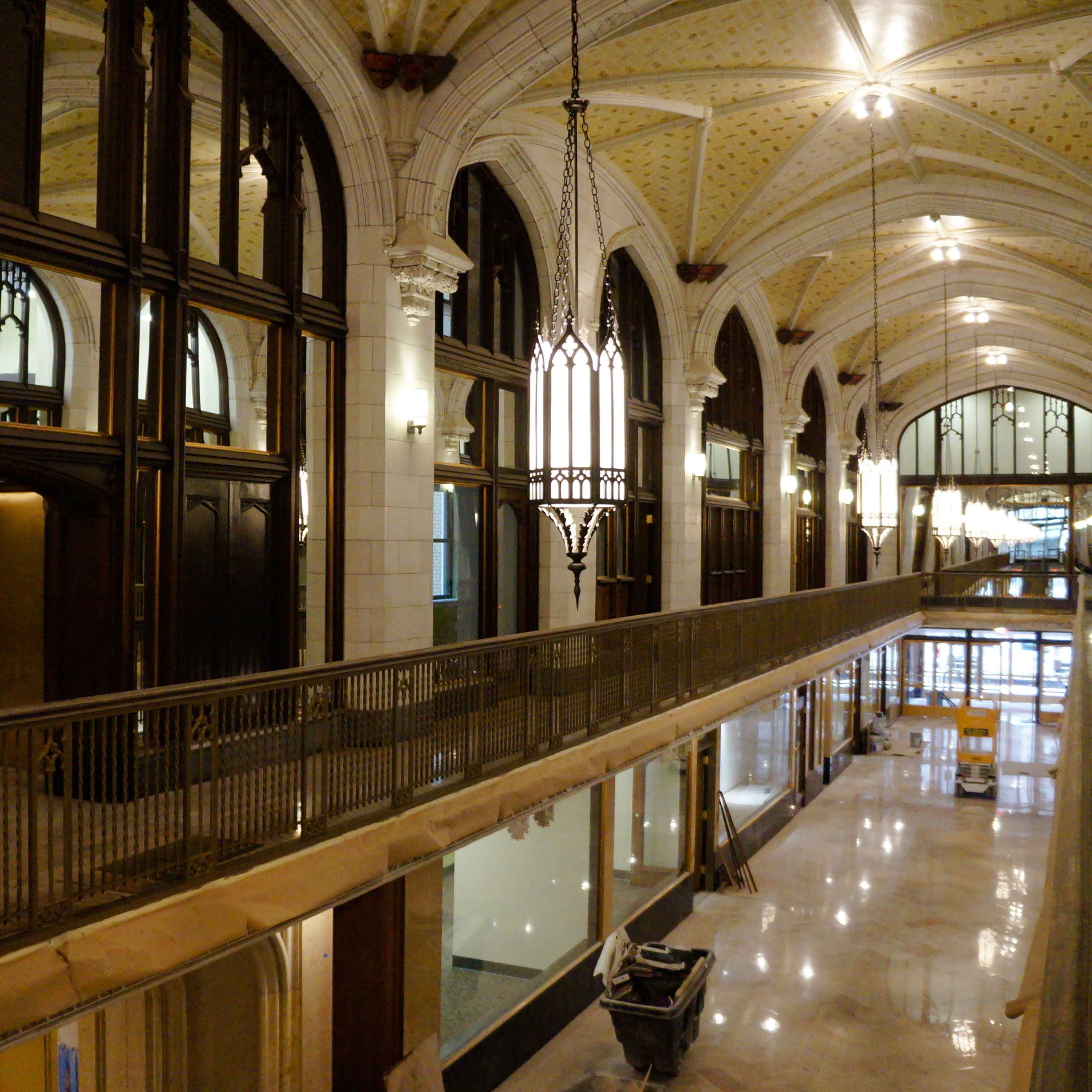Webster University Gateway Campus Opens in Historic Arcade Building
December 21, 2015

ST. LOUIS – It has been nearly three decades since the last time the Arcade Building was open for business. That will all change Jan. 4 when the building will come to life with Webster University graduate students starting classes in this new location. Undergraduate students will begin one week later on Jan. 11.
The University will host an open house for media and community partners at 3 p.m. Jan. 11, the first day that the space is fully used. A reception will be held and tours offered. The public is welcome to attend.
“After four decades in downtown St. Louis, Webster is deepening and expanding our longstanding commitment to downtown and the region with the opening of our Gateway Campus in the Arcade Building,” said Elizabeth (Beth) Stroble, president of Webster University. “The new space will better serve those who live and work downtown. We will partner with the entrepreneurial community, add to downtown St. Louis vibrancy with leading edge academic programs such as Cybersecurity, Criminology, Legal Studies and others, and provide space for major speakers, art exhibitions, lunch-time learning, and community gatherings.”
“It’s a new era for serving students in downtown St. Louis,” said Julian Schuster, provost, senior vice president and chief operating officer. “As Webster enters its second century, it seems fitting to begin the New Year with this fabulous facility that will further build our capacity to offer transformative academic programs. This venue will allow for collaboration and innovation through the arts and sciences.”
The University is the anchor tenant in the Arcade Building, which Dominium Development finished renovating in early December. The University has been moving in furniture and installing electronics in its 54,000 square-feet of space since then. Webster University occupies the first and second floors of the building as well as the mezzanine level.
Webster’s first-floor space includes offices for student services and administration, an art museum and 130+-seat auditorium for lectures and other live events. The Gorlok Grind, a book store/coffee shop open to the public is expected to open mid-January and is located on the first floor with an external entrance at the corner of Pine and 8th streets. The mezzanine area has more offices. The second floor has offices for faculty, meeting areas for students, and classrooms. The rest of the building has been developed into apartments and will be managed by Dominium. It is expected that some of the Arcade space will be made available to companies, organizations and the general public to rent as event space.
Webster University’s main campus in Webster Groves opened in 1915. In the St. Louis region, it also has locations in downtown St. Louis, in Westport, WingHaven and at Scott Air Force Base. The combination of Webster’s spaces in the Old Post Office and the Arcade building make up the newly-named Webster University Gateway Campus.
This month, Webster’s academic programs and services in the Old Post Office are relocating to the Arcade Building. Webster’s space in the Old Post Office hosts several University institutes and community partners, such as the Confucius Institute, the World Affairs Council and the Diversity Awareness Partnership. Some of those entities will remain in the Old Post Office while others will move to the Arcade Building. Any empty space in Webster’s area of the Old Post Office will be subleased to local businesses and organizations.
Webster University opened its first downtown St. Louis location in 1975 at Broadway and Locust Street. In 2004, the University relocated the downtown location to become the anchor tenant for the renovated Old Post Office. Its building lease expires in 2019.
The redevelopment of Old Post Office Square (bordered by Olive Street on the south, Locust Street on the north, Eighth Street on the east and Ninth Street on the west) has long been recognized as critical to the vibrancy of downtown St. Louis. When the project began in 1997 there were 70 empty buildings in downtown St. Louis. The Old Post Office was the first building revitalized in the 20-year project. With the completion of the Arcade building, there is only one empty building left in the area — the Chemical Building, located one block from the Arcade building.
The Arcade building, completed in 1919, was joined with the Wright Building, originally built in 1906. It was one of the first indoor shopping malls in the United States and one of the tallest concrete structures in the world. The Arcade Building was designated a city landmark in 1980 and was listed on the National Register of Historic Places in 2003.
Because of its historic nature, much of the original Gothic terra cotta moldings and other architectural features were restored. Some of the original windows in the arcade portion of the building also have been restored, such as windows that advertise former businesses, including “The St. Louis Wrestling Club” and the “St. Louis Ticket Office.”
“This space will bring people together to live, work, study and collaborate,” Schuster said. “What people bring to this space are their dreams and a vision for a better future for themselves, for their families and for their communities.”
For more information on the Gateway Campus, including the 22 graduate, undergraduate and certificate programs offered on site and a complete history of the building, visit https://www.webster.edu/gateway.
With its main campus in St. Louis, Missouri, USA, Webster University (www.webster.edu) comprises an action-oriented global network of faculty, staff, students and alumni who forge powerful bonds with each other and with their communities around the globe. Founded in 1915, Webster is a private non-profit university with almost 20,000 students studying at campus locations in North America, Europe, Asia and Africa and in a robust learning environment online. The university is committed to delivering high-quality learning experiences that transform students for global citizenship and individual excellence.
